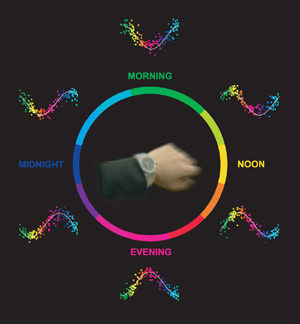| RIKEN Center for Developmental Biology (CDB) 2-2-3 Minatojima minamimachi, Chuo-ku, Kobe 650-0047, Japan |
| Got the time? Development of a molecular timetable by analysis of circadian gene expression |
||
August 12, 2004 - A look inside a wristwatch reveals that timekeeping is a complex affair, involving the coordination of mechanical parts providing the impulses and feedback needed to achieve precisely recurring movement. Biological clocks are equally complex, regulated by a network of genes and transcriptional factors that interact to stabilize the rhythms of numerous physiological systems. Unlike the wristwatch, however, there is no visible readout or display showing an individual's body time, a lack which has stood as one of the major barriers to realizing the promise of chronotherapy, which seeks to deliver drug treatments at optimal body times. A new study by Hiroki R. Ueda (Laboratory for Systems Biology, RIKEN Center for Developmental Biology; Kobe, Japan) and colleagues has provided proof of principle that just such a display of individual body time may one day be possible. The report, published in the August 3 issue of the Proceedings of the National Academy of Sciences, describes the analysis of the expression of more than 100 time-indicating genes in the mouse. The results of this genome-wide study enabled the authors to develop a "molecular timetable" that provides an accurate representation of the animal's body time based on the sampling of gene expression levels at a single point in time.
Many genes exhibit variable expression cycles roughly over the course of a 24-hour day, a phenomenon known as circadian rhythmicity. In their study, Ueda et al . first identified genes that are expressed in high amplitude circadian patterns. Such genes demonstrate cyclical expression irrespective of variations in exposure to light, maintaining their amplitude and periodicity even when the animals are kept in constant darkness. The team identified 168 genes fulfilling these criteria in samples from mouse liver, and calculated their peak expression times in terms of both external time and the animal's subjective inner clock. They found that the genes could be organized into a kind of daily schedule by their times of peak expression - some were expressed most highly at daybreak, some at dusk, some at other time-points throughout the cycle of a single day. By plotting the expression levels of the entire set of time-indicating genes against a 24-hour curve, Ueda and colleagues found that it is possible to determine body time with a high degree of accuracy. To test the robustness of this molecular time measurement system, they measured the expression levels of the 168 genes at the lights-out phase in animals kept in conditions of alternating 12-hour periods of light and dark. This phase is presumed to be a hotbed of circadian regulatory activity, as the mouse's internal rhythm runs in cycles that are naturally shorter than 24 hours, and darkness serves as a stimulus for resetting the circadian clock (such stimuli are referred to as Zeitgeber mechanisms, from the German word meaning "time-giver"). Their analysis of expression levels at this critical Zeitgeber hour 12 produced estimated body times to an accuracy of about 1 hour in all animals studied, indicating that the molecular timetable provided is strongly resistant to environmental noise (in this case, variation in exposure to light). They next tested the system in mice with a homozygous mutation in the gene Clock , whose loss of function is known to perturb the natural circadian rhythm. They found rhythm disruptions in the expression profiles of all of the Clock / Clock mice, suggesting that the molecular timetable approach may also have applications in the diagnosis of circadian rhythm disorders. This new approach to the horology of the body has been validated in mice of varying genetic backgrounds and in principle can be applied to any organism exhibiting biological clock activity, a range that spans the living world from bacteria to plants to humans. And indeed a test of the method in wild type and Clock -mutant fruit flies gave similar results to those in the mouse studies. The development by Ueda and colleagues of a universally-applicable, specific, sensitive and accurate method capable of both detecting individual body time and of diagnosing circadian disorders represents a major step toward the fulfillment of the longstanding dream of scientists and physicians: to put a readable face on the body's clock. Its application in medical treatment may one day allow doctors to tailor drug administration to a patient's body time, which promises to optimize efficacy and reduce adverse effects.. |
||
|
||
[ Contact ] Douglas Sipp : sipp@cdb.riken.jp TEL : +81-78-306-3043 RIKEN CDB, Office for Science Communications and International Affairs |
| Copyright (C) CENTER FOR DEVELOPMENTAL BIOLOGY All rights reserved. |
